CellufineTMGH-25
For rapid protein desalting buffer exchange and removal of alcohol and detergents
Cellufine GH-25 desalting media is based on porous, spherical, highly crosslinked cellulose particles. The sharp 3kD exclusion limit allows proteins to pass through the column in the void volume while retarding smaller molecular weight solutes in the internal pores. Outstanding mechanical strength allows operation at high flow rates even in large diameter process scale columns, thus minimizing run times.
Features
- Mechanical robust spherical particle
- Efficient salt removal
- Hydrophilic
- Pre-swollen
- pH stable 1 – 14 (0.1M HCl, 0.5M NaOH)
- Resistant to organic solvents
- Autoclavable (121 °C, 30 min)
Benefit
- Enables high flow rates and short run times
- Permits large sample loads (typical: 5 – 30 minute run times in columns from 1 ml to 100 liters, with loads up to 35 % bed volume)
- Low non-specific adsorption, high recovery
- Easy packing
- Easy cleaning and depyrogenation
- Permits use with all commonly used solvents and buffers without shrinkage or swelling
- Sterilizable
| Characteristics | |
|---|---|
| Matrix | Crosslinked cellulose |
| Particle Size | ca. 40-130 μm |
| Gel Exclusion Limit | 3kD |
| Efficiency | 98 % to 100 % recovery. No deterioration after 250 days, 1000 cycles. |
| Autoclavable | 121 °C, 30 min. |
| Pressure Resistance | No collapse at up to 870 ml/h/cm2 flow in large columns |
| pH Stability | pH 1 – 14 |
| Chemical Resistance | Resistance to detergents and dissociating agents. No change after 30 days in 0.1M HCl or 0.1M NaOH. |
| Supplied | Suspension in 20 % ethanol |
Flow Properties
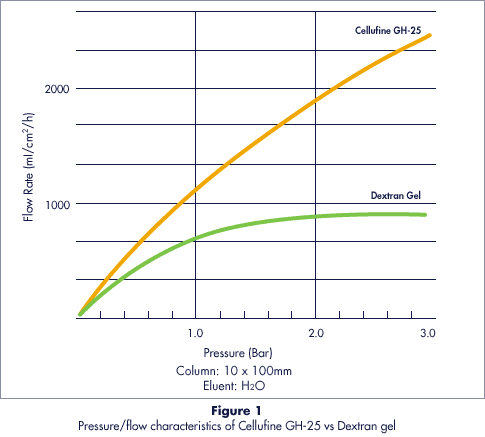
Due to its rigidity, Cellufine GH-25 delivers nearly twice
the flow rate of an equivalent sized Dextran gel.
The specific selection curve of Cellufine GH-25
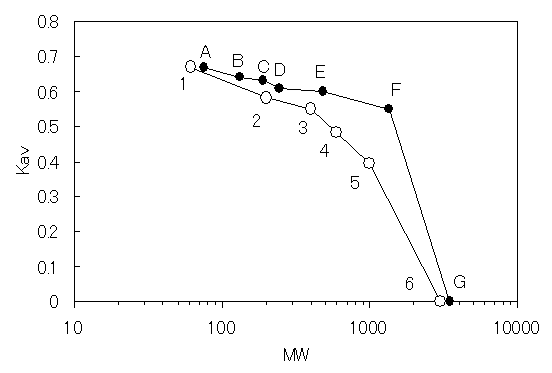
1:Ethylene glycol (M.W.62), 2:PEG (M.W.200), 3:PEG (M.W.400), 4:PEG (M.W.600), 5:PEG (M.W.1,000), 6:PEG (M.W.3,000), A:Glycine (M.W.75), B:Glycinex2 (M.W.132), C:Glycine x3 (M.W.189), D:Glycine x4 (M.W.246), E:Calcium pantothenate (M.W.477), F:Vitamin B12 (M.W.1,355), G:Insulin β chain (M.W.3,495)
The feature of Cellfine GH-25 is a unique separation pattern. As you can be seen from the relationship between molecular weight and Kav in the above figure, Kav of molecular weight 1,000 and 3,000 are largely separated. This indicates that it is very advantage for separation of low molecular weight compounds from high molecular weight compounds such as proteins.
Applications
- Desalting before lyophilization or concentration
- Buffer exchanges
- Removal of alcohol or other organic solvents
- Removal of aromatic compounds (e.g., phenol) in purification of nucleic acids
- Removal of detergents used to solubilize proteins (e.g. Triton® X-100, SDS)
- Permits use with all commonly used solvents and buffers without shrinkage or swelling
- Removal of chaotropic agents, (e.g. urea, guanidine)
High Speed Desalting
Although the rigidity of Cellufine GH-25 makes it ideally suited to large scale column use, its ability to operate at very high flow rates enables the use of smaller columns running multiple cycles giving similar throughput to lower flow rates on larger columns. Unlike conventional chromatography, the performance (as measured by sample load, salt removal, and dilution) of desalting chromatography can actually improve as the flow rate increases, due to decreased sample dilution at high volumetric loads.
Protein Desalting
Cellufine GH-25 was evaluated separation of the salt from various proteins. The separation of various proteins and sodium chloride are extremely sharp and the recovery rates are almost 100%.
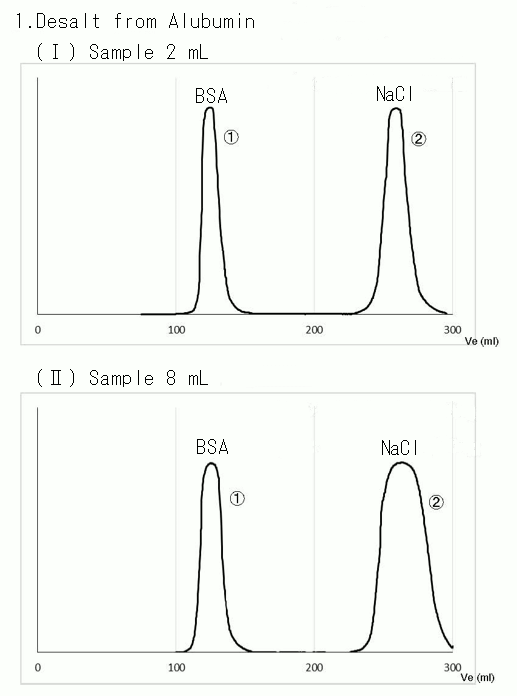
- Column
- H2.6cm x H60 cm Vt = 318 ml
- Mobile phase
- 0.05 M Ammonium formate
- Flow rate
- 36 ml/hr, 6.8 cm/hr
- Sample
- (Ⅰ) BSA 30 mg, NaCl 150 (Ⅱ) 300 mg, NaCl 1,500 mg
- Load volume
- (Ⅰ) 2ml (Ⅱ) 8 ml
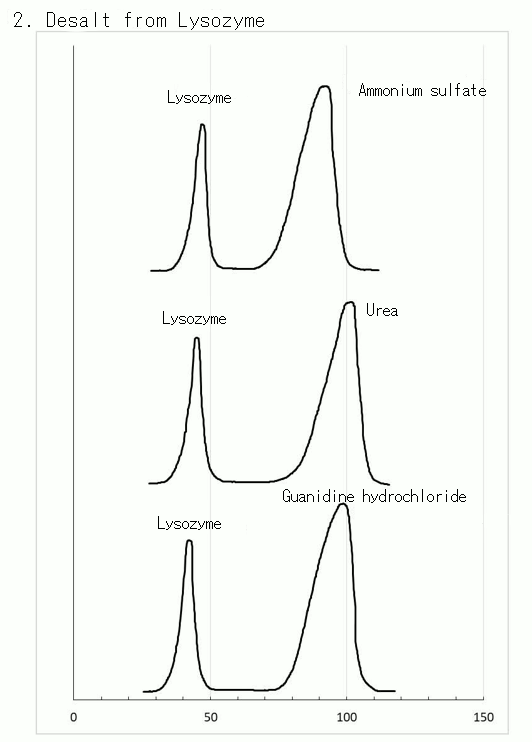
- Column
- H1.6cm x H52 cm Vt = 104 ml
- Mobile phase
- 0.05 M Ammonium formate
- Flow rate
- 42 ml/hr, 21 cm/hr
- Sample
- Lysozyme 30 mg Sodium chloride 150mg
- Load volume
- 2ml
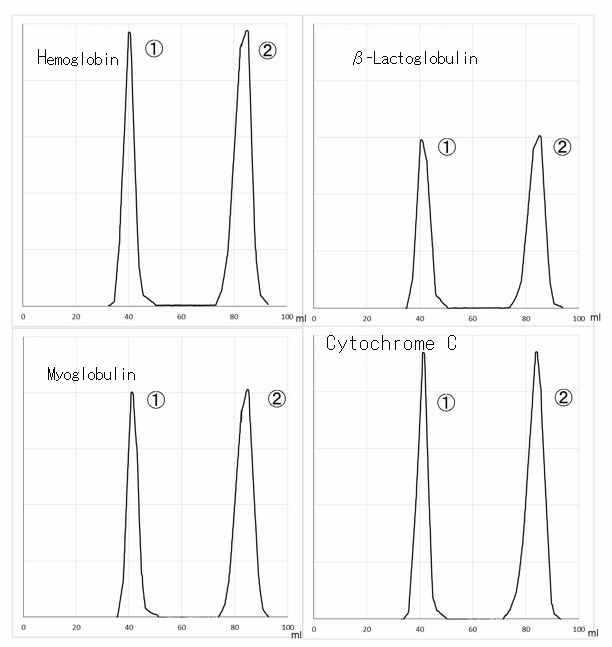
- Column
- H1.5cm x H49 cm Vt = 86 ml
- Mobile phase
- 0.05 M Ammonium formate
- Flow rate
- 30 ml/hr, 17 cm/hr
- Sample
- Various proteins 50 mg, NaCl 250mg
- Load volume
- 2ml
Alcohol Removal
Fractionation of human blood and the subsequent removal of alcohol from the albumin are two important elements of albumin production. Table 1 compares alcohol removal from albumin with GH-25 gel at two different flow rates. Increasing the flow rate does not affect de-alcoholization efficiency, albumin recovery or sample dilution. Concentration of the remaining alcohol was below 0.01 % for either flow rate. Cycle time was reduced to one quarter by increasing flow from 29 cm/h/cm² to 100 cm/h/cm² .
| Run Number | 1 | 2 |
|---|---|---|
| Gel type | GH-25 | GH-25 |
| Column diameter (mm) | 50 | 50 |
| Column diameter length (mm) | 680 | 670 |
| Gel volume (ml) | 1335 | 1320 |
| Flow rate (ml/hr) | 570 | 2010 |
| Linear velocity (ml/h/cm²) | 29 | 102 |
| Time needed for a cycle (hr) | 2.3 | 0.6 |
| Product Applied | ||
| Process volume (ml) | 310 | 310 |
| Process volume (% Vt) | 23 | 23 |
| Albumin concentration (%) | 12 | 12 |
| Ethanol concentration (%) | 4.8 | 4.8 |
| Product Collected | ||
| Recovered volume of product (ml) | 546 | 525 |
| Dilution factor | 1.8x | 1.7x |
| Recovered albumin concentration (%) | 6.6 | 6.9 |
| Remaining alcohol concentration (%) | 0.002 | 0.01 |
| Mass recovery of albumin (%) | 97 | 98 |
Table 1Alcohol removal from human albumin fractionation procedure
Industrial Desalting
The advantages of desalting biological molecules chromatographically are clearly realized in large-scale applications. From research to pilot and production facility, the scale-up of Cellufine GH-25 has proven to be direct and trouble-free. Mechanical stability of GH-25 allows the use of high flow rates in large columns.
A typical large scale desalting application requiring the processing of 225 liters per day can be accomplished by 5 liters of Cellufine GH-25 in a 105 x 587 mm column (see Table 2). This rigid gel withstands flow rates to 1250 ml/min in that column geometry (870 ml/cm/cm²). Cycle time between injections is 8 minutes. The high volume load (25 % of Vt), is accommodated by the packing without sacrificing resolution or purity.
| Packing | Cellufine GH-25 |
|---|---|
| Column (mm) | 105 x 587 |
| Vt | 5.1 liters |
| Flow rate (ml/min)(liters/hr) | 1250(75 liters/hr) |
| Linear velocity | 870 ml/h/cm² |
| Product | 5 % w/v protein in 1.5M NaCL |
| Product volume | 1.27 liters (25 % of Vt) |
| Product mass/cycle | 63.6g |
| Cycles/day | 180 |
| Product mass/day | 11.4kg |
| Protein mass recovery | 99.5 % |
| Salt exchange | 99 % (0.015M final conc.) |
| Sample dilution | 1.13 |
| Total product volume recovered | 257 liters |
| Total product volume processed per day | 225 liters |
Table 2Throughput analysis for high speed desalting
- Cellufine GH-25
